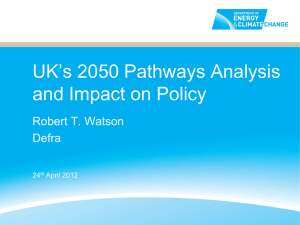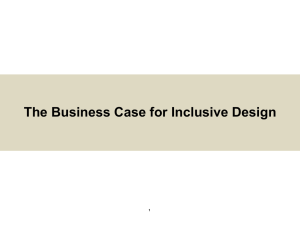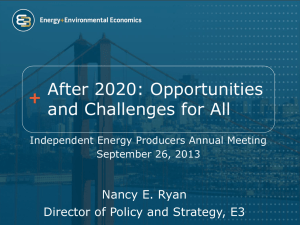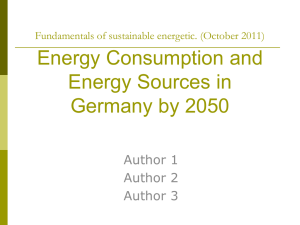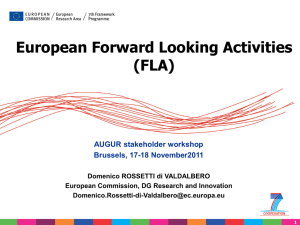results and methodology
advertisement
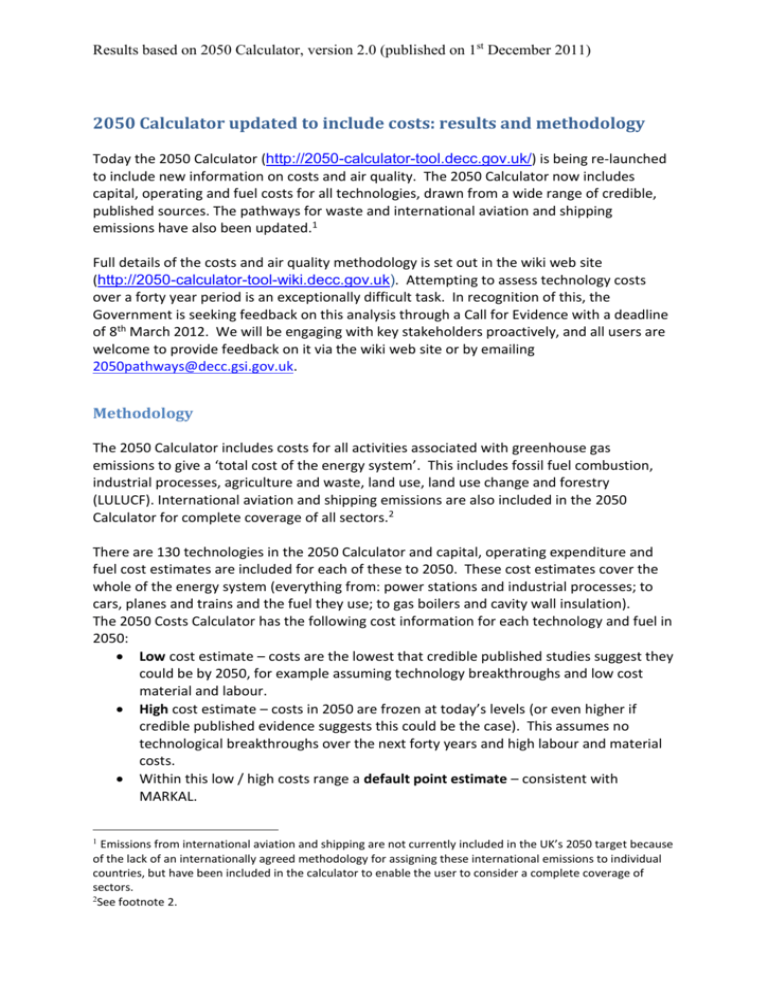
Results based on 2050 Calculator, version 2.0 (published on 1st December 2011) 2050 Calculator updated to include costs: results and methodology Today the 2050 Calculator (http://2050-calculator-tool.decc.gov.uk/) is being re-launched to include new information on costs and air quality. The 2050 Calculator now includes capital, operating and fuel costs for all technologies, drawn from a wide range of credible, published sources. The pathways for waste and international aviation and shipping emissions have also been updated.1 Full details of the costs and air quality methodology is set out in the wiki web site (http://2050-calculator-tool-wiki.decc.gov.uk). Attempting to assess technology costs over a forty year period is an exceptionally difficult task. In recognition of this, the Government is seeking feedback on this analysis through a Call for Evidence with a deadline of 8th March 2012. We will be engaging with key stakeholders proactively, and all users are welcome to provide feedback on it via the wiki web site or by emailing 2050pathways@decc.gsi.gov.uk. Methodology The 2050 Calculator includes costs for all activities associated with greenhouse gas emissions to give a ‘total cost of the energy system’. This includes fossil fuel combustion, industrial processes, agriculture and waste, land use, land use change and forestry (LULUCF). International aviation and shipping emissions are also included in the 2050 Calculator for complete coverage of all sectors.2 There are 130 technologies in the 2050 Calculator and capital, operating expenditure and fuel cost estimates are included for each of these to 2050. These cost estimates cover the whole of the energy system (everything from: power stations and industrial processes; to cars, planes and trains and the fuel they use; to gas boilers and cavity wall insulation). The 2050 Costs Calculator has the following cost information for each technology and fuel in 2050: Low cost estimate – costs are the lowest that credible published studies suggest they could be by 2050, for example assuming technology breakthroughs and low cost material and labour. High cost estimate – costs in 2050 are frozen at today’s levels (or even higher if credible published evidence suggests this could be the case). This assumes no technological breakthroughs over the next forty years and high labour and material costs. Within this low / high costs range a default point estimate – consistent with MARKAL. 1 Emissions from international aviation and shipping are not currently included in the UK’s 2050 target because of the lack of an internationally agreed methodology for assigning these international emissions to individual countries, but have been included in the calculator to enable the user to consider a complete coverage of sectors. 2 See footnote 2. Results based on 2050 Calculator, version 2.0 (published on 1st December 2011) The cost estimates in the 2050 Costs Calculator are drawn from a wide range of credible, published sources. Sources include economic and energy models (in particular MARKAL), sectoral analysis (Parsons Brinckerhoff, Mott MacDonald, AEA, NERA), UK Government Departments, independent analytical bodies such as the Committee on Climate Change and wherever possible the real world cost of technologies as reported by financial bodies or the media. The 2050 Calculator includes no new evidence about costs, it simply brings together existing published assumptions. The unit used for presenting the costs in the 2050 webtool is £/person/year on average from 2010 to 2050. These costs should not be confused with the bills households pay for their electricity and heating. For full details of the costs methodology, see: http://2050-calculator-toolwiki.decc.gov.uk/pages/28 Results The 2050 Calculator shows that the total ‘cost of the energy system’ today is around £3,700/person/year and that if we do not tackle climate change,3 the total cost of the energy system could be £4,682/person/year on average over the next forty years. The capital, operating and fuel costs of tackling climate change could be similar to doing nothing and may be cheaper than remaining fossil fuel dependent (even if fossil fuel prices are not high). For example, a pathway developed to approximate the ‘core’ run of the cost optimising model, MARKAL, for DECC’s analysis for the fourth carbon budget, would meet the UK’s target to cut emissions 80% by 2050, maintain energy security, and save the economy £84/person/year compared to not tackling climate change (see the “analogous to MARKAL” pathway). In the MARKAL pathway, energy use per person in 2050 is half today’s levels; around three quarters of this is due to uptake of more efficient technologies. However, there are certain costs associated with the move to a low carbon economy, which this analysis does not capture (such as wider macroeconomic impacts and the inconvenience from living in cooler buildings). And, critically, this analysis does not take into account any of the benefits associated with the move to a low carbon economy. These include:1. The avoided devastating damages of climate change – the Stern Review estimated this environmental cost at up to 20% of GDP per year globally, a figure that helps contextualise the cost of mitigating climate change, which he estimated to be 1-2% of GDP globally.4 2. The benefits of greater energy security. If the UK did nothing to tackle climate change, the proportion of our energy we get from imported fossil fuels will rise from “Not tackling climate change” is defined as level 1 action across all sectors in the Calculator. Stern Review (2006) http://webarchive.nationalarchives.gov.uk/+/http:/www.hmtreasury.gov.uk/sternreview_index.htm 3 4 Results based on 2050 Calculator, version 2.0 (published on 1st December 2011) around 23% in 2007 to 53% in 2020 and 88% in 2050, meaning that our spending on net imported fossil fuels would rise from around £10bn today to £32bn in 2020 to £86bn in 2050. This would leave the UK more vulnerable to fossil fuel shortages and price spikes. However, if we meet our 80% target, then by 2050 imported fossil fuels could account for only 7-30% of our energy, at a cost of £8-24bn5. 3. Investment in the green economy is a strong driver of economic growth and jobs. The global low carbon market is projected to reach £4 trillion by 2015 as economies around the world invest in low carbon technologies. Investment in renewables, globally, already outstripping investment in fossil fuels. By 2015, over 1 million people in the UK are expected to be employed in the green economy.6 Another important caveat to the analysis is that the costs the combination of technologies chosen by the user and does not take into account price interactions between supply and demand. Attempting to ‘pick’ a single pathway to 2050 by relying on a single model is neither possible, nor a helpful guide in the face of uncertainty. The Government has therefore developed three further ‘2050 futures’ to stress test the MARKAL pathway for changes that we cannot predict in the development, cost and public acceptability of different technologies in every sector of the economy. These three 2050 futures are “higher renewables, high energy efficiency”, “higher nuclear, low energy efficiency” and “high CCS, high bioenergy”. Each of these achieves an 80% reduction in greenhouse gas emissions,7 maintains energy security and costs £368-499/person/year more than remaining fossil fuel dependent. There is considerable uncertainty around future costs. The 2050 Calculator therefore allows users to sensitivity test the results for their pathway. Doing so for the three 2050 futures shows that, if fossil fuel prices were high and certain key clean technologies fell rapidly in price, then the 2050 futures could be cheaper than doing nothing. For example: the “higher renewables, more energy efficiency” pathway could be cheaper than doing nothing if oil and gas prices were high ($170/bbl and 100p/therm), domestic insulation were low cost; and electric cars and buses were low cost. the “higher nuclear, less energy efficiency” pathway could be cheaper than doing nothing if oil and gas prices were high ($170/bbl and 100p/therm), domestic insulation and domestic heating were low cost; and electric and hybrid cars and buses were low cost. the “higher CCS, less bioenergy” future could be cheaper than doing nothing if oil and gas prices were high ($170/bbl and 100p/therm), domestic insulation and 5 Range based on three Carbon Plan pathways: higher renewables, high energy efficiency; higher nuclear, low energy efficiency; higher CCS, high bioenergy 6 Innovas (2009) (http://webarchive.nationalarchives.gov.uk/20100511081713/http://www.bis.gov.uk/files/file50253.pdf) 7 Each of these pathways reduces all greenhouse gas emissions (including international aviation and shipping) by 80% by 2050. International aviation and shipping emissions are not currently included in the 2050 target: Government will make a decision next year about whether to include them. Results based on 2050 Calculator, version 2.0 (published on 1st December 2011) domestic heating were low cost; hybrid cars and buses were low cost; biomatter to fuel conversion were low cost; and industrial processes were low cost. Finally, a selection of independent experts have used the 2050 Calculator to estimate the incremental cost of their pathways over and above doing nothing. They have taken account of the other implications of their pathways, which the Calculator allows users to investigate, such as the impact on balancing, the impact on use of UK land, the impact on air quality etc. The results are: Friends of the Earth (generation from wind, marine renewables and hydro; ambitious demand reduction) £503/person/year; The National Grid (wide range of generation sources; moderate demand reduction; considerable bioenergy) £209/person/year; The Campaign to Protect Rural England (offshore renewables, solar, geothermal and electricity imports; ambitious demand reduction.) £359/person/year; Atkins (energy from a range of sources, emphasis on UK self-reliance) £604/person/year; and Mark Brinkley, author of the Housebuilder’s Bible, (marine renewable, geothermal and algae supply; some nuclear and CCS) £801/person/year.



